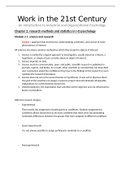Work in the 21st Century
An introduction to Industrial and Organizational Psychology
Chapter 2: research methods and statistics in I-O psychology
Module 2.1: science and research
Science = approach that involves the understanding, prediction, and control of some
phenomenon of interest
All sciences also share common methods by which they study the objects of interest:
1. Science is marked by a logical approach to investigation, usually based on a theory, a
hypothesis, or simply a basic curiosity about an object of interest.
2. Science depends on data.
3. Science must be communicable, open, and public. Scientific research is published in
journals, reports, and books. As a result, other scientists or nonscientists can draw their
own conclusions about the confidence they have in the findings of the research or even
replicate the research themselves.
4. Science does not set out to prove theories or hypotheses. It sets out to disprove them.
The goal of the scientist is to design a research project that will eliminate all plausible
explanations for a phenomenon except one.
5. Disinterestedness: the expectation that scientists will be objective and not influenced by
biases or prejudices.
Different research designs:
Experimental
They involve the assignment of participants to conditions. Random assignment to
conditions allows researchers to be more confident that there were not preexisting
systematic differences between the groups that were assigned to different conditions.
Quasi-experimental
It is not always possible to assign participants randomly to a condition.
Nonexperimental
, They do not include any "treatment” or conditions. In a nonexperimental design, the
researcher would simply gather information about the effects of a pay plan without
introducing any condition or treatment. Researchers often use the term “independent
variable” to describe the treatment or antecedent condition and the term "dependent
variable” to describe the subsequent behavior of the research participants.
Observational design: the researcher watches an employee's behavior and
makes a record about what is observed
Survey design: the worker is asked to complete a questionnaire describing
typical interaction frequency with his or her supervisor
Methods of data collection:
Quantitative methods
They rely on tests, rating scales, questionnaires, and psychological measures. They yield
results in terms of numbers.
Qualitative methods
They generally produce flow diagrams and narrative descriptions of events or processes,
rather than numbers as measures. They include procedures such as observations,
interviews, case studies, and analysis of diaries or written documents.
Much of the resistance to qualitative research is the result of viewing it as excessively
subjective. This concern is misplaced. All methods of research ultimately require
interpretation, regardless of whether they are quantitative or qualitative.
The added value of qualitative research is that it helps to identify the context for the
behavior in question.
One of the most important issues in conducting research is how widely the results can be
generalized -> an investigator can generalize results to areas that have been sampled in the
research study.
Module 2.2: data analysis
,Descriptive statistics
= statistics that summarize, organize, and describe a sample of data
Three measures can be used to describe any score distribution:
1. Measure of central tendency
= statistic that indicates where the center of a distribution is located. Mean, median,
and mode are measures of central tendency
Mean = arithmetic average of the scores
Mode = most frequently occuring score
Median = middle score
2. Variability
= the extent to which scores in a distribution vary
3. Skew
= the extent to which scores in a distribution are lopsided or tend to fall on the left or
right side of the distribution
Standard deviation = variance of a distribution
Inferential statistics
= statistics used to aid the researcher in testing hypotheses and making inferences from
sample data to a larger sample of population
Statistical significance is defined in terms of a probability statement. To say that a finding of
difference between two groups is significant at the 5 percent level, or a probability of 0.05, is to
say that a difference that large would be expected to occur only 5 times out of 100 as a result of
chance alone.
Statistical power = the likelihood of finding a statistically significant difference when a
true difference exists
Correlation and regression
, Correlation coefficient = statistic assessing the bivariate, linear association between two
variables. Provides information about both the magnitude and the direction of the
relationship between two variables
The concept of correlation
Scatterplot = graph used to plot the scatter of scores on two variables; used to display
the correlational relationship between two variables
Regression line = straight line that best “fits” the scatterplot and describes the
relationship between the variables in the graph; can also be presented as an equation
that specifies where the line intersects the vertical axis and what the angle or slope of
the line is
The correlation coefficient
The correlation coefficient’s absolute value will always range between 0.00 and 1.00. A high
value represents a strong association, and a lower value represents a weaker association. A
positive correlation means that there is a positive association between the variables. A negative
correlation means that as one variable goes up, the other variable tends to go down.
The relationship might be nonlinear. Although the correlation coefficient might be 0.00, one
cannot conclude that there is no association between the variables. We can conclude that there
is no linear association.
Multiple correlation
Multiple correlation coefficient = statistic that represents the overall linear association
between several variables on the one hand and a single variable on the other hand
Correlation and causation
Correlation coefficients simply represent the extent to which two variables are associated. They
do not signal any cause-effect relationship.
Meta-analysis





